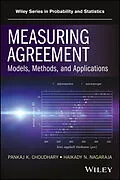Presents statistical methodologies for analyzing common types of data from method comparison experiments and illustrates their applications through detailed case studies
Measuring Agreement: Models, Methods, and Applications features statistical evaluation of agreement between two or more methods of measurement of a variable with a primary focus on continuous data. The authors view the analysis of method comparison data as a two-step procedure where an adequate model for the data is found, and then inferential techniques are applied for appropriate functions of parameters of the model. The presentation is accessible to a wide audience and provides the necessary technical details and references. In addition, the authors present chapter-length explorations of data from paired measurements designs, repeated measurements designs, and multiple methods; data with covariates; and heteroscedastic, longitudinal, and categorical data. The book also:
. Strikes a balance between theory and applications
. Presents parametric as well as nonparametric methodologies
. Provides a concise introduction to Cohen's kappa coefficient and other measures of agreement for binary and categorical data
. Discusses sample size determination for trials on measuring agreement
. Contains real-world case studies and exercises throughout
. Provides a supplemental website containing the related datasets and R code
Measuring Agreement: Models, Methods, and Applications is a resource for statisticians and biostatisticians engaged in data analysis, consultancy, and methodological research. It is a reference for clinical chemists, ecologists, and biomedical and other scientists who deal with development and validation of measurement methods. This book can also serve as a graduate-level text for students in statistics and biostatistics.
Autorentext
P. K. CHOUDHARY, PhD, is Professor in the Department of Mathematical Sciences at the University of Texas at Dallas. Currently, he is also the Associate Head of the department. His research interests include development of statistical methodology for biostatistical applications, and he has published extensively in the field of method comparison studies.
H. N. NAGARAJA, PhD, is Professor Emeritus at The Ohio State University where he has served in the Departments of Statistics and Internal Medicine and the Division of Biostatistics. He is a fellow of the American Statistical Association and the American Association for the Advancement of Science, and an elected member of the International Statistical Institute. His published works include Order Statistics, Third Edition (with H. A. David) and Records (with B. C. Arnold and N. Balakrishnan), both published by Wiley.
Inhalt
Preface xv
1 Introduction 1
1.1 Preview 1
1.2 Notational Conventions 1
1.3 Basic Characteristics of a Measurement Method 2
1.3.1 A Statistical Model for Measurements 3
1.3.2 Quality Characteristics 3
1.4 Method Comparison Studies 5
1.5 Meaning of Agreement 6
1.6 A Measurement Error Model 8
1.6.1 Identifiability Issues 9
1.6.2 ModelBased Moments 10
1.6.3 Conditions for Perfect Agreement 10
1.6.4 Link to Test Theory 11
1.7 Similarity versus Agreement 11
1.7.1 Evaluation of Similarity 11
1.7.2 Evaluation of Agreement 12
1.8 A Toy Example 13
1.9 Controversies and Our View 14
1.10 Concepts Related to Agreement 15
1.11 Role of Confidence Intervals and Hypotheses Testing 16
1.11.1 Formulating the Agreement Hypotheses 16
1.11.2 Testing Hypotheses Using Confidence Bounds 17
1.11.3 Evaluation of Agreement Using Confidence Bounds 17
1.11.4 Evaluation of Similarity Using Confidence Intervals 18
1.12 Common Models for Paired Measurements Data 18
1.12.1 A Measurement Error Model 19
1.12.2 A MixedEffects Model 20
1.12.3 A Bivariate Normal Model 21
1.12.4 Limitations of the Paired Measurements Design 22
1.13 The BlandAltman Plot 23
1.13.1 The Ideal Plot 23
1.13.2 A Linear Trend in the BlandAltman Plot 25
1.13.3 Heteroscedasticity in the BlandAltman Plot 26
1.13.4 Variations of the BlandAltman Plot 27
1.14 Common Regression Approaches 29
1.14.1 Ordinary Linear Regression 29
1.14.2 Deming Regression 31
1.15 Inappropriate Use of Common Tests in Method Comparison Studies 34
1.15.1 Test of Zero Correlation 34
1.15.2 Paired ttest 36
1.15.3 PitmanMorganand BradleyBlackwood Tests 36
1.15.4 Test of Zero Intercept and Unit Slope 38
1.16 Key Steps in the Analysis of Method Comparison Data 39
1.17 Chapter Summary 40
1.18 Bibliographic Note 41
Exercises 47
2 Common Approaches for Measuring Agreement 53
2.1 Preview 53
2.2 Introduction 53
2.3 Mean Squared Deviation 54
2.4 Concordance Correlation Coefficient 54
2.5 A Digression: Tolerance and Prediction intervals 57
2.5.1 Definitions 57
2.5.2 Normally Distributed Data 58
2.6 Lin's Probability Criterion and BlandAltman Criterion 59
2.7 Limits of Agreement 60
2.7.1 The Approach 60
2.7.2 Why Ignore the Variability? 61
2.7.3 Limits of Agreement versus Prediction and Tolerance Intervals 62
2.8 Total Deviation Index and Coverage Probability 62
2.8.1 The Approaches 62
2.8.2 Normally Distributed Differences 63
2.9 Inference on Agreement Measures 64
2.10 Chapter Summary 64
2.11 Bibliographic Note 65
Exercises 66
3 A General Approach for Modeling and Inference 71
3.1 Preview 71
3.2 MixedEffects Models 71
3.2.1 The Model 72
3.2.2 Prediction 73
3.2.3 Model Fitting 74
3.2.4 Model Diagnostics 75
3.3 A LargeSample Approach to Inference 76
3.3.1 Approximate Distributions 77
3.3.2 Confidence Intervals 78
3.3.3 Parameter Transformation 80
3.3.4 Bootstrap Confidence Intervals 81
3.3.5 Confidence Bands 83
3.3.6 Test of Homogeneity 83
3.3.7 Model Comparison 84
3.4 Modeling and Analysis of Method Comparison Data 85
3.5 Chapter Summary 88
3.6 Bibliographic Note 89
Exercises 89
4 Paired Measurements Data 95
4.1 Preview 95
4.2 Modeling of Data 95
4.2.1 MixedEffects Model 95
4.2.2 Bivariate Normal Model 97
4.3 Evaluation of Similari...
